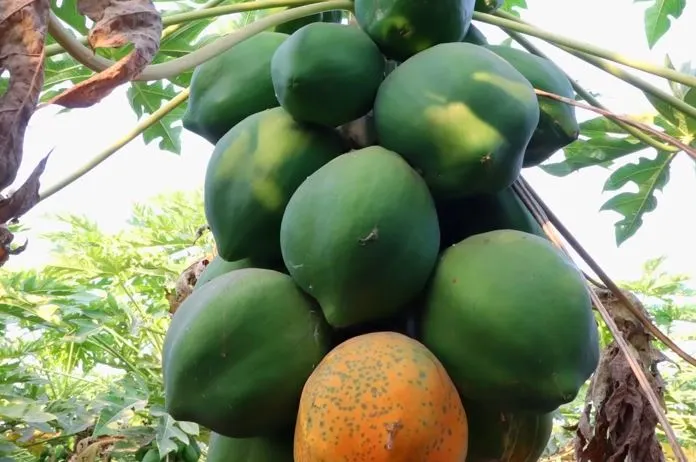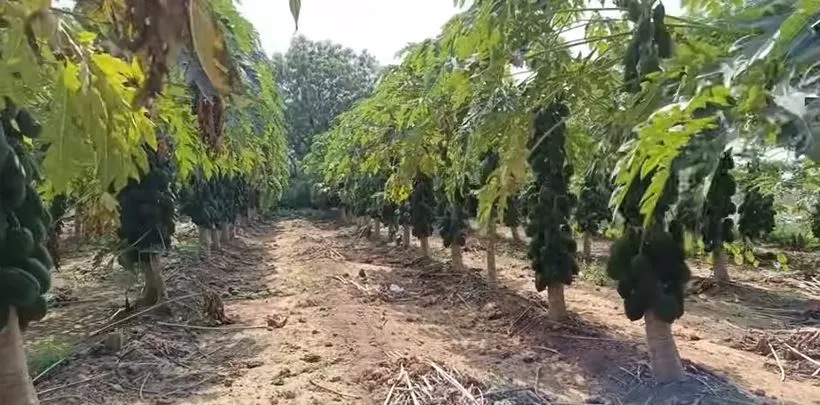Papaya Farming Profit Per Acre : Earn Up to 8 Lacs
Papaya, known for its sweet taste and numerous health benefits, is a popular tropical fruit cultivated in many parts of the world. Its high demand in the market makes it a lucrative option for farmers. This article aims to provide a comprehensive analysis of the potential profit per acre from papaya farming, offering guidance to farmers and investors on the financial aspects of papaya cultivation.
Understanding Papaya Cultivation |Papaya Farming Profit Per Acre
Climatic and Soil Requirements
Papayas thrive in tropical and subtropical climates with temperatures ranging from 21°C to 33°C. They require well-drained, fertile soils with a pH between 6 and 6.5. Adequate sunlight and water are crucial for optimal growth.
Varieties of Papaya
Commonly cultivated varieties include Red Lady, Pusa Dwarf, and Solo. Red Lady is known for its high yield and disease resistance, Pusa Dwarf is suitable for small-scale farming, and Solo is popular for its sweet taste and export quality.
Initial Investment and Setup Costs | Papaya Farming Profit Per Acre
Land Preparation
Preparing the land involves plowing, leveling, and soil treatment, costing approximately ₹10,000 per acre. Setting up an irrigation system may cost around ₹20,000 per acre.
Planting Material
The cost of papaya seeds or seedlings can range from ₹5,000 to ₹10,000 per acre, depending on the variety and source. Planting density is usually around 900 to 1,100 plants per acre.
Infrastructure and Equipment
Necessary infrastructure includes fencing to protect the crops from animals, costing about ₹15,000 per acre. Basic equipment like spades, hoes, and sprayers might cost an additional ₹10,000.

Operational Costs | Papaya Farming Profit Per Acre
Labor Costs
Labor is required for planting, maintenance, and harvesting. The annual labor cost per acre is estimated to be around ₹30,000 to ₹40,000, depending on local wage rates.
Fertilization and Pest Control
Fertilizers and pesticides are essential for healthy crop growth. The cost of fertilizers can be around ₹8,000 per acre annually, while pest control measures might cost another ₹5,000.
Irrigation and Water Management
The cost of water and irrigation management, including electricity for pumping water, is approximately ₹5,000 per acre annually. Regular maintenance of the irrigation system may add another ₹2,000 to the annual expenses.
Yield and Harvesting | Papaya Farming Profit Per Acre
Expected Yield per Acre
On average, a well-managed papaya farm can yield around 25 to 30 tonnes per acre. The yield depends on factors like variety, soil fertility, and climatic conditions.
Harvesting Process
Harvesting papayas is labor-intensive and involves careful handling to avoid damage. The cost of harvesting, including labor and transportation to the market, is estimated to be around ₹15,000 per acre.

Marketing and Sales | Papaya Farming Profit Per Acre
Market Analysis
Papayas have a steady demand in both local and international markets. Prices can fluctuate based on supply and demand dynamics. On average, papayas sell for around ₹10 to ₹15 per kilogram in local markets.
Sales Channels
Farmers can sell their produce through local markets, wholesalers, direct sales to consumers, or export. Transportation and distribution costs may vary but typically amount to about ₹5,000 per acre.
Profit Calculation | Papaya Farming Profit Per Acre
Revenue Estimation
The estimation of papaya farming for one acre of land is outlined here. The values projected in the tables below may vary depending on the location of the farm area and also largely depend on the cost of raw materials in the local market. Labor cost, transport, etc. may also differ for each area. It’s important to note that these values should be taken as a reference only and not for the real implementation of papaya farming practices.
Estimated Production
- Total Production: 1 acre of land produces 35 tonnes (35,000 kg)
Market Price
- Price per kg: Rs 27.00
Estimated Fruit Loss
- Loss Percentage: 5%
- Fruit Loss: 5% of 35,000 kg = 1,750 kg
- Total Produce After Loss: 35,000 kg – 1,750 kg = 33,250 kg
Total Revenue
- Revenue: 33,250 kg @ Rs 27/kg = Rs 898,750.00
Total Cost of Implementation
|
Component |
Cost (IN Rs.) |
|
Planting material (saplings) |
17,000.00 |
| Manure and fertilizers |
10,000.00 |
| Insecticides and pesticides | 500.00 |
| Labour cost | 20,000.00 |
| Infrastructure for drip irrigation | 35,000.00 |
| Drip irrigation for Fertigation | 50,000.00 |
|
Shed for the labor |
10,000.00 |
| Farm needs | 5,000.00 |
| Land development | 10,000.00 |
|
Fencing |
25,000.00 |
| Total cost of implementation | 182,500.00 |
Profit Estimation
The profit from papaya farming is calculated as follows: Profit=Total Revenue−Total Cost of Implementation\text{Profit} = \text{Total Revenue} – \text{Total Cost of Implementation}Profit=Total Revenue−Total Cost of Implementation Profit=Rs898,750.00−Rs182,500.00=Rs716,250.00\text{Profit} = Rs 898,750.00 – Rs 182,500.00 = Rs 716,250.00Profit=Rs898,750.00−Rs182,500.00=Rs716,250.00
Therefore, the estimated profit from one acre of papaya farming is Rs 716,250.00.

Risk Management and Sustainability | Papaya Farming Profit Per Acre
Common Risks in Papaya Farming
Papaya farming faces risks such as pests, diseases, and adverse weather conditions. Papaya ringspot virus and powdery mildew are common diseases that can significantly affect yield.
Risk Mitigation Strategies
Implementing integrated pest management, using disease-resistant varieties, and ensuring proper irrigation can mitigate risks. Additionally, farmers should consider crop insurance to protect against potential losses.
Sustainable Farming Practices
Sustainable practices such as organic farming, efficient water use, and soil conservation can enhance long-term profitability. Reducing chemical inputs and adopting environmentally friendly techniques can also attract premium prices in niche markets.
Conclusion | Papaya Farming Profit Per Acre
Summary of Key Points
Papaya farming can be highly profitable, with potential earnings of ₹2,06,250 per acre. Key considerations include understanding the climatic requirements, managing operational costs, and effectively marketing the produce.
Final Thoughts
Papaya farming offers a promising opportunity for farmers and investors willing to adopt best practices and manage risks. With the growing demand for papayas, the future outlook for this industry remains positive.
FAQs on Papaya Farming Profit Per Acre | Papaya Farming Profit Per Acre